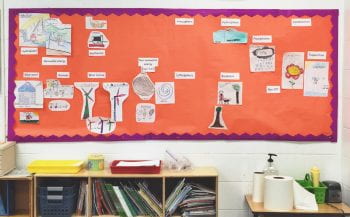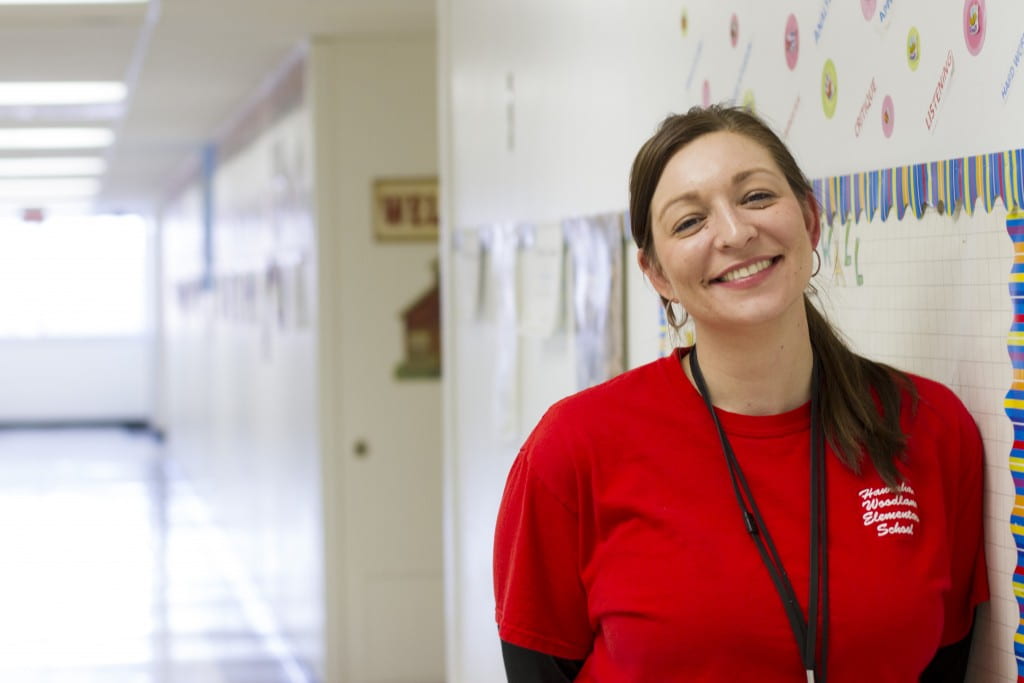Even as the sun begins to dip at the end of a long school day, light still streams through the big windows in Kandace Ortiz’s classroom at Hanrahan Elementary in Jennings School District. Colorful artwork, stacks of books and piles of assignments hint at the 60 students that file in and out of her room each day.
Ortiz looks at home behind her desk. Without asking, it would be hard to guess that this is her first year teaching in a fifth grade classroom. In fact, in the fall of 2014, Ortiz not only made the leap from teaching kindergarten to fifth grade but also from teaching reading for the majority of her day to teaching science and social studies instead.
“It was a big change,” said Ortiz, an understatement to say the least.
She goes on to explain that everything about the two grades is different, from discipline and classroom management to teaching style and content. Perhaps the hardest change for her was the science content.
In many kindergarten classrooms, science consists of simple concepts such as whether items are living or nonliving and vocabulary like stem, leaf and flower. In 5th grade, the concepts are much more complex.

Ortiz points out the vocabulary word wall on one end of her classroom. On the board, students have posted drawings of different vocabulary words like geothermal, hydropower and biomass. Ortiz, smiling and shaking her head, said that it’s incredible how detailed and accurate their drawings are and how well they’ve grasped what she’s taught.
In order to teach these concepts, Ortiz, along with a few other science teachers in the district, uses a science curriculum developed by the Institute for School Partnership at Washington University in St. Louis. The program is called MySci. It bases its units around a question and provides teachers with hands-on science materials to help students engage, explore for themselves and, ultimately, answer the question.
“I always enjoyed science, but I haven’t seen a lot of the concepts since I was in school,” Ortiz said. “But I feel like a pro now. MySci has helped me so much.”
Although she has gained confidence in teaching science, Ortiz said there are a few things that she misses about her kindergarten classroom.
“I absolutely loved teaching reading,” Ortiz said. “What I miss the most is having the student come in really low (in reading proficiency) and then leaving and seeing how far that they have progressed based on the strategies that they learned in my room.”
Teaching science and social studies, however, has not stopped her from continuing to influence her students in the area of reading. At the beginning of each science unit, Ortiz meets with the school librarian. From there, the librarian puts together a bundle of books for Ortiz and her students that relate to the topic.
Ortiz said that she uses the books in a variety of ways; for example, when the students rotate through stations, one might be a hands-on station, while another could be a reading station.
“The other day, the reading teacher came to me and said, ‘Ms. Ortiz, have you taught renewable resources?’” Ortiz said that she had, and the other teacher told her that almost all her students scored 85 percent or higher on a cold-read on renewable resources. It was all because they had background knowledge from her science class.
“I know that the students are learning,” Ortiz said, even without the affirmation from her fellow educators. For each science unit, Ortiz gives her students a pre-test and a post-test to assess just how much the students have learned.
“From the pre-test to the post-test, the difference is crazy,” Ortiz said. She believes that it is the structure of the science lessons that makes the difference. The MySci curriculum encourages students to ask questions themselves and to explore science in a hands-on way.
“They might forget what I say,” Ortiz said, “but they don’t forget what they do.”
March 2015 | by, Gennafer Barajas
